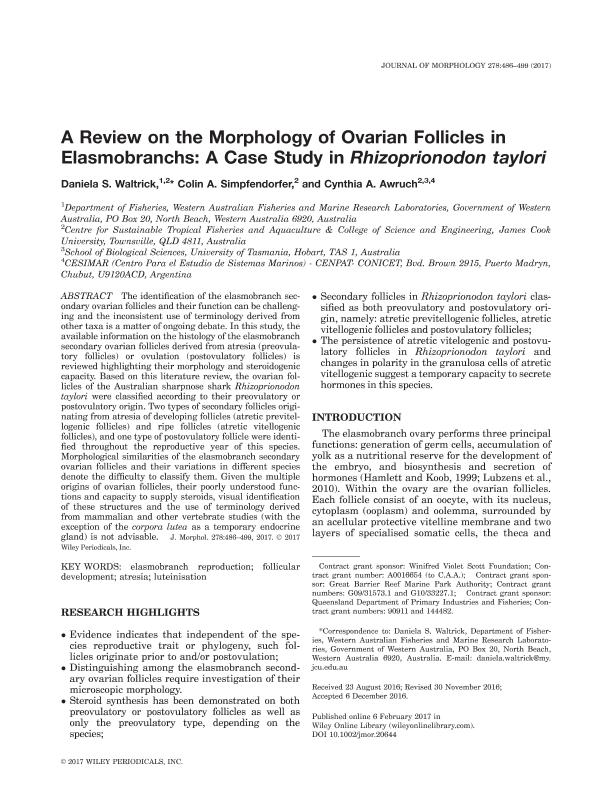Artículo
A review on the morphology of ovarian follicles in elasmobranchs: A case study in Rhizoprionodon taylori
Fecha de publicación:
04/2017
Editorial:
Wiley-liss, Div John Wiley & Sons Inc
Revista:
Journal of Morphology
ISSN:
0362-2525
e-ISSN:
1097-4687
Idioma:
Inglés
Tipo de recurso:
Artículo publicado
Clasificación temática:
Resumen
The identification of the elasmobranch secondary ovarian follicles and their function can be challenging and the inconsistent use of terminology derived from other taxa is a matter of ongoing debate. In this study, the available information on the histology of the elasmobranch secondary ovarian follicles derived from atresia (preovulatory follicles) or ovulation (postovulatory follicles) is reviewed highlighting their morphology and steroidogenic capacity. Based on this literature review, the ovarian follicles of the Australian sharpnose shark Rhizoprionodon taylori were classified according to their preovulatory or postovulatory origin. Two types of secondary follicles originating from atresia of developing follicles (atretic previtellogenic follicles) and ripe follicles (atretic vitellogenic follicles), and one type of postovulatory follicle were identified throughout the reproductive year of this species. Morphological similarities of the elasmobranch secondary ovarian follicles and their variations in different species denote the difficulty to classify them. Given the multiple origins of ovarian follicles, their poorly understood functions and capacity to supply steroids, visual identification of these structures and the use of terminology derived from mammalian and other vertebrate studies (with the exception of the corpora lutea as a temporary endocrine gland) is not advisable. J. Morphol. 278:486–499, 2017.
Palabras clave:
Atresia
,
Elasmobranch Reproduction
,
Follicular Development
,
Luteinisation
Archivos asociados
Licencia
Identificadores
Colecciones
Articulos(CESIMAR)
Articulos de CENTRO PARA EL ESTUDIO DE SISTEMAS MARINOS
Articulos de CENTRO PARA EL ESTUDIO DE SISTEMAS MARINOS
Citación
Waltrick, Daniela S.; Simpfendorfer, Colin A.; Awruch, Cynthia Andrea; A review on the morphology of ovarian follicles in elasmobranchs: A case study in Rhizoprionodon taylori; Wiley-liss, Div John Wiley & Sons Inc; Journal of Morphology; 278; 4; 4-2017; 486-499
Compartir
Altmétricas




